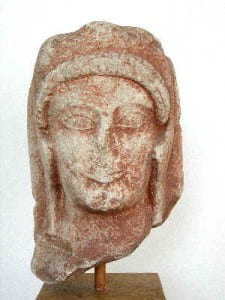 This head of Herakles (right) is located in the National Museum in Athens, Greece. The label in the museum states that the head is from Lycia and is believed to represent Omphale. This information is based on the initial publication of the piece in 1899 by P Kastriotis (ArchEph 1899, 51-6). Since this publication, scholars (e.g., SCE 4.2, 332 and Hermary LIMC 5.1, 196) have noted that the figure is almost certainly not Omphale, but rather an image of Herakles in his typical Cypriote guise. However, the provenience of Lycia has not been challenged; to the contrary, it has been used to support the wide distribution of the type. The type does appear outside of the island particularly in the Near East (e.g., Al Mina, Amrit) and possibly even as far west as Rome (see especially the statue of Herakles from the archaic temple in the sanctuary at Sant’ Omobono (illustrated in R. Ross Holloway, The Archaeology of Early Rome and Latium, London, 1994, 79). The type is clearly derived from the familiar Herakles image in Cyprus (often referred to as ‘Cypriote Herakles’ due to the lack of epigraphical testimonia), characterized by the right arm, raised and holding a club which is then attached to the back of the head.Profile and top views clearly show the attachment for the club (now missing). The typology, as well as the material (limestone), leaves little doubt that the piece was either sculpted on Cyprus or by an itinerant Cypriote sculptor. The sharp, angular facial features (especially the bowed mouth and prominent cheek bones) are reminiscent of styles associated with the region of Vouni (see Gaber-Saletan 1981) and may suggest that the piece was produced there before making its way to Lycia. The location of Vouni on the north coast of the island facing Asia Minor would appear to support such a hypothesis.
This head of Herakles (right) is located in the National Museum in Athens, Greece. The label in the museum states that the head is from Lycia and is believed to represent Omphale. This information is based on the initial publication of the piece in 1899 by P Kastriotis (ArchEph 1899, 51-6). Since this publication, scholars (e.g., SCE 4.2, 332 and Hermary LIMC 5.1, 196) have noted that the figure is almost certainly not Omphale, but rather an image of Herakles in his typical Cypriote guise. However, the provenience of Lycia has not been challenged; to the contrary, it has been used to support the wide distribution of the type. The type does appear outside of the island particularly in the Near East (e.g., Al Mina, Amrit) and possibly even as far west as Rome (see especially the statue of Herakles from the archaic temple in the sanctuary at Sant’ Omobono (illustrated in R. Ross Holloway, The Archaeology of Early Rome and Latium, London, 1994, 79). The type is clearly derived from the familiar Herakles image in Cyprus (often referred to as ‘Cypriote Herakles’ due to the lack of epigraphical testimonia), characterized by the right arm, raised and holding a club which is then attached to the back of the head.Profile and top views clearly show the attachment for the club (now missing). The typology, as well as the material (limestone), leaves little doubt that the piece was either sculpted on Cyprus or by an itinerant Cypriote sculptor. The sharp, angular facial features (especially the bowed mouth and prominent cheek bones) are reminiscent of styles associated with the region of Vouni (see Gaber-Saletan 1981) and may suggest that the piece was produced there before making its way to Lycia. The location of Vouni on the north coast of the island facing Asia Minor would appear to support such a hypothesis.